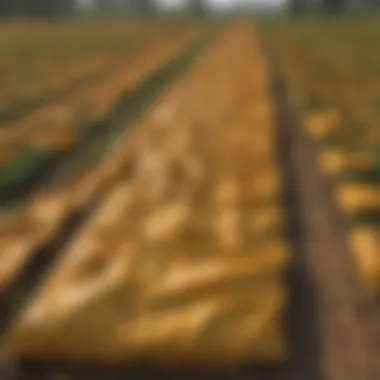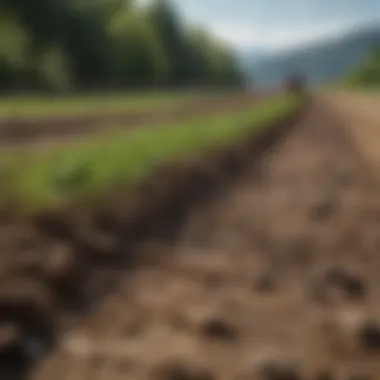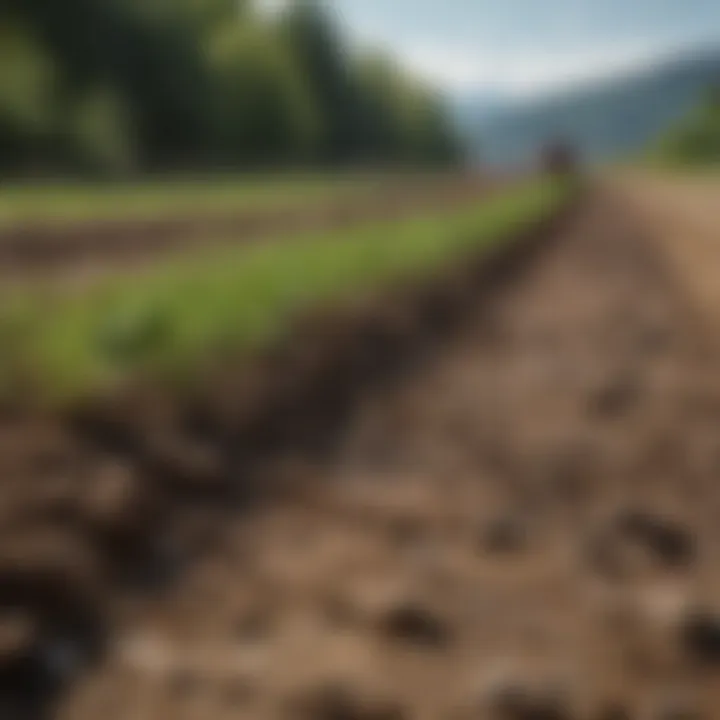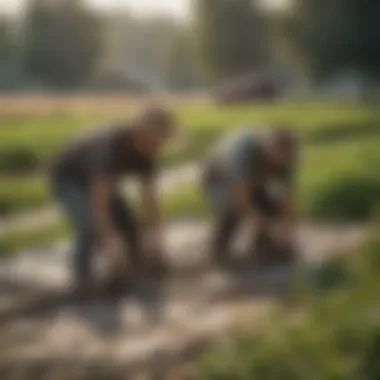Understanding Anti Weed Tarps in Modern Agriculture


Overview of the Topic
In the bustling world of modern agriculture, effective weed management stands out as a crucial component for successful crop production. Anti weed tarps have emerged as significant tools to combat the challenge posed by unwanted vegetation. By preventing sunlight from reaching the soil, these tarps disrupt the natural growth cycle of weeds, allowing desirable crops a competitive edge.
Definition and Importance
Anti weed tarps are typically made from durable materials, designed to be laid across the soil surface. Their primary purpose is to inhibit weed growth by blocking light, thereby reducing the seed germination rate. This technique not only protects crops but also can significantly improve soil health. An effective tarping strategy can contribute to moisture retention and minimize the need for chemical herbicides, aligning with sustainable farming practices.
Current Trends
In recent years, there has been a noticeable shift toward sustainable practices in agriculture. Farmers increasingly recognize the value of eco-friendly solutions, such as anti weed tarps. Many are exploring biodegradable options that break down over time, further benefiting the soil and surrounding ecosystem. This trend reflects a broader commitment to nurturing the environment while enhancing agricultural productivity.
Key Techniques and Practices
For farmers looking to implement anti weed tarps, understanding the proper techniques and practices is essential.
Step-by-Step Guide
- Site Preparation: Before laying down the tarp, clear the area of existing weeds and debris. This ensures maximum effectiveness.
- Choosing the Right Tarp: Select a tarp based on the specific needs of your crops and the local climate. This may include factors like thickness and material.
- Laying the Tarp: Spread the tarp evenly over the prepared soil, ensuring it covers all intended areas. Fix it in place using weights or pegs to prevent it from blowing away.
- Monitoring: Regularly check under the tarp to assess soil moisture levels and the effectiveness of weed suppression. Adjust as necessary.
- Removal and Follow-Up: Depending on the crop cycle, remove the tarp when planting time approaches. Follow with crop planting, allowing the soil to retain its improved condition.
Tools and Equipment Needed
- Durable anti weed tarps (e.g., landscape fabric)
- Garden pegs or weights
- Soil prep tools (e.g., hoes, rakes)
- Watering equipment (for soil moisture management)
Challenges and Solutions
Despite their advantages, utilizing anti weed tarps can present challenges.
Common Obstacles
- Soil Temperature: Prolonged tarp use may cause soil temperature fluctuations, affecting crop germination.
- Moisture Levels: Incorrect tarp usage can lead to overly dry soils if not monitored.
Innovative Solutions
To overcome these challenges, farmers can monitor soil conditions closely and adjust tarp usage according to climatic changes. Using tarps that allow some water infiltration can mitigate moisture issues. Additionally, consulting agronomy professionals can provide tailored solutions for specific crops and environments.
"Implementing anti weed tarps is a proactive strategy in modern agriculture, fostering both productivity and sustainability."
As the agriculture community continues to explore methods of enhancing crop yield while embracing environmental stewardship, the role of anti weed tarps is set to gain further significance.
Intro to Anti Weed Tarps
Anti weed tarps have emerged as a significant tool in modern agriculture, particularly in the context of sustainable farming practices. They play a vital role in controlling weed growth while promoting healthier crop conditions. Understanding these tarps is essential for farmers and agricultural enthusiasts seeking to improve their yields and soil quality.
Definition and Purpose
Anti weed tarps are specialized materials designed to suppress weed growth by blocking sunlight and limiting access to nutrients and moisture. Made from various materials, these tarps serve multiple purposes. One primary function is to prevent light from reaching weeds, essentially starving them of the energy needed for growth. Additionally, the tarps help in regulating soil temperature and moisture levels. This aids in creating a more favorable environment for crops while also reducing the need for chemical herbicides.
The use of anti weed tarps directly supports sustainable farming practices. By minimizing the dependence on harmful chemicals, farmers can protect not only their crops but also the surrounding ecosystems. Furthermore, these tarps can contribute to soil health by preserving moisture and reducing erosion, promoting a more balanced agricultural system.
Historical Context
The concept of using coverings to manage weeds and improve crop conditions is not new. Historically, farmers have sought various methods to combat weed growth. From using mulches made from organic materials to more advanced tarping methods, the journey of weed management has evolved significantly.
In the past, tarps were often made from natural materials such as cloth or paper. However, these were not always effective in providing long-lasting weed control. The development of synthetic materials, particularly polypropylene, marked a transformative moment in weed management. These materials offer durability and effectiveness that surpasses previous organic methods. Today, the adoption of anti weed tarps reflects a blend of traditional practices and modern technology. As climate concerns continue to rise, these tarps are being recognized for their environmental benefits as well.
"Anti weed tarps represent a crucial evolution in sustainable agricultural practices, enabling farmers to effectively manage weeds with reduced chemical input."


With a growing focus on sustainable agriculture, understanding the role of these tarps provides critical insights into their value in contemporary farming. As research continues to highlight their benefits, the relevance of anti weed tarps in effective weed management becomes increasingly evident.
Mechanisms of Action
Understanding how anti weed tarps function is essential for effectively employing them in farming practices. These tarps serve various critical roles that collectively enhance crop growth while minimizing the detrimental effects of weeds. Key aspects include weed suppression techniques, soil temperature regulation, and moisture retention properties. Each of these mechanisms contributes to creating an ideal environment for plants while suppressing unwanted vegetation.
Weed Suppression Techniques
Anti weed tarps are primarily designed to suppress weed growth. This is achieved by blocking sunlight, which is a fundamental requirement for photosynthesis in plants. The materials used in these tarps can obstruct light penetration effectively. Tarps made from polypropylene or similar materials can create a barrier that prevents the weeds from germinating.
Weed control through tarping is often more efficient than chemical methods. Chemicals can leach into the soil and cause long-term environmental harm. On the other hand, tarps provide a more sustainable solution. Moreover, tarps can help manage specific weed species based on the frequency of their growth cycles. By carefully selecting the time of installation, farmers can maximize the impact of the tarp against the weed population.
Soil Temperature Regulation
Soil temperature plays a significant role in plant health. Anti weed tarps can regulate soil temperature by providing insulation, particularly during colder months. When a tarp is placed over the soil, it traps heat underneath. This is especially beneficial for seedlings and young plants that are often vulnerable to temperature fluctuations.
In addition to keeping the soil warm, tarps can also mitigate overheating during warmer seasons. Farmers can manage the microclimate around their crops effectively. For instance, the use of black or dark-colored tarps can help absorb heat, raising the soil temperature when needed. Conversely, lighter-colored or translucent tarps can reflect harmful rays while allowing some light, which aids in maintaining a balanced soil temperature for various plants.
Moisture Retention Properties
Moisture is essential for plant growth, and anti weed tarps assist in retaining soil moisture. When applied appropriately, these tarps reduce evaporation from the soil. This is particularly useful during dry spells or in arid regions where water conservation is critical.
The tarps create a protective barrier that minimizes exposure to wind and sun, both of which can rob the soil of moisture. Furthermore, by retaining moisture, the tarps help create a more favorable environment for root development and nutrient absorption. This leads to healthier plants that are better equipped to compete against weeds.
By amalgamating these mechanisms, anti weed tarps present a comprehensive strategy for modern agricultural practices.
Materials Used in Anti Weed Tarps
The selection of materials used in anti weed tarps plays a crucial role in their effectiveness and overall sustainability. Different materials offer unique benefits that can cater to various agricultural needs and environmental conditions. Understanding these materials helps farmers make informed decisions that align with both agricultural practices and ecological concerns.
Polypropylene Tarps
Polypropylene tarps are among the most popular options for weed management. These tarps are made from a synthetic polymer that is known for its durability and resistance to weather conditions. They can withstand UV exposure, which is essential for longevity in outdoor applications. Additionally, polypropylene tarps are relatively lightweight, making them easier to handle during installation.
One significant advantage of using polypropylene is its ability to suppress light. By blocking sunlight, these tarps effectively inhibit the growth of weeds beneath them. This feature not only aids in weed management but also reduces the need for chemical herbicides, leading to a more sustainable farming approach.
However, there are considerations. Although durable, polypropylene is not biodegradable. This raises concerns about long-term environmental impact, especially if the tarps are not disposed of properly. Farmers often have to consider the balance between effectiveness and environmental responsibility when choosing this material.
Biodegradable Options
Biodegradable tarps are gaining traction in modern agriculture due to their environmental benefits. Made from organic materials such as cornstarch or other plant-based substances, these tarps break down naturally over time. They serve the same purpose as traditional tarps while reducing pollution and waste in agricultural settings.
One of the key benefits of biodegradable options is their contribution to soil health. As these tarps decompose, they can improve soil structure and nutrient content, enhancing the overall ecosystem of the agricultural land. However, it is essential to note that the effectiveness of these tarps depends on proper usage and local environmental conditions.
Farmers should also consider the cost of biodegradable tarps, as they can be more expensive than synthetic alternatives. While the long-term ecological benefits are appealing, upfront costs might be a barrier for some, necessitating careful financial planning and assessment.
Thermal Blankets
Thermal blankets represent another effective material used in anti weed applications. These tarps are designed to regulate soil temperature by providing insulation. In colder regions, they can help retain heat, promoting earlier planting and potentially increasing yields. Similarly, warmer climates benefit from the cooling properties of these materials, helping to maintain suitable conditions for crops.
The unique property of thermal blankets is the ability to influence the microclimate under the tarp. This can lead to enhanced seed germination and root growth, as the regulated environment supports healthier plants.
While these benefits are significant, thermal blankets can be more specialized and may not be suitable for all cropping systems. Farmers must assess their specific needs to determine whether the investment in thermal technology will yield a positive return.
In summary, the choice of materials for anti weed tarps significantly impacts their effectiveness and sustainability. Farmers must weigh the advantages and drawbacks of each to make decisions that align with their agricultural practices and environmental values.
By understanding these materials, farmers can implement better weed management strategies, ultimately leading to improved crop productivity and sustainable farming practices.


Installation and Maintenance
Effective installation and maintenance of anti weed tarps are critical for achieving maximum utility in modern agriculture. Properly installed tarps not only provide a barrier against weeds but also protect the underlying crops and soil health. Maintenance measures ensure longevity and consistent performance over time, which can lead to significant cost savings and increased productivity. Each step in this process, from pre-installation planning to ongoing care, is essential for garnering the benefits these tarps offer.
Pre-Installation Considerations
Before laying down an anti weed tarp, several considerations should be made to ensure optimal performance.
- Site Assessment: Examine the intended area for tarping. Check for existing weed populations and the soil condition. Analyzing the terrain helps in choosing the right tarp type.
- Timing: The ideal installation period often aligns with a pre-planting phase. Installing too late can lead to germination of weeds. Understanding local weather patterns can help synchronize tarp placement effectively.
- Tarp Selection: Different materials serve distinct purposes. Tarps made from polypropylene, for example, are durable but might lack biodegradability. Consider how environmental impact plays into your decision.
- Local Regulations: Some areas may have specific guidelines surrounding the use of tarps. It's important to familiarize oneself with local agricultural policies to avoid compliance issues.
Step-by-Step Installation Guide
Installing an anti weed tarp requires attention to detail. The following step-by-step guide simplifies the process:
- Prepare the Soil: Remove any existing weeds, rocks, or debris from the area. A clear surface facilitates better contact with the tarp.
- Measure and Cut: Tailor the tarp to the specific dimensions of your planting area. Allow for some overlap on edges to secure the tarp properly.
- Lay the Tarp: Spread the tarp evenly across the designated area. Ensure there are no air pockets, as these can lead to uneven weed growth underneath.
- Secure the Edges: Use landscape fabric pins, weights, or soil to anchor the edges. This prevents movement during high winds or heavy rains.
- Monitor Regularly: After installation, observe its efficacy. Check for any signs of water pooling, which could indicate inadequate drainage.
Regular Maintenance Protocols
To extend the lifespan and effectiveness of anti weed tarps, regular maintenance is necessary. Here are some protocols to incorporate:
- Visual Inspections: Conduct routine checks for signs of wear and tear. Look for cracks, tears, or areas that have slipped out of place.
- Cleaning: Remove any debris that may accumulate on top of the tarp. This reduces potential moisture issues that can lead to fungal growth.
- Reinforcement: Over time, edges may require resecuring to combat erosion. Adding more pins or weights can help.
- Adjustments: Be flexible and ready to adjust your strategy based on environmental changes and the effectiveness of the tarp. Adaptation is key in successful weed management strategies.
"Consistent maintenance is a crucial part of integrating anti weed tarps into modern agricultural practices."
Understanding and implementing these steps ensure that farmers and agricultural enthusiasts can derive the maximum advantages of anti weed tarps, leading to robust crop yields and sustainable farming practices.
Effectiveness in Weed Management
In the realm of modern agriculture, effective weed management is paramount. Weeds can compete with crops for nutrients, water, and sunlight, ultimately reducing yield. Anti weed tarps emerged as a strategic approach to combat this issue. By forming a barrier over soil, they exclude light, thus impeding the growth of unwanted plant species. This section explores various facets of the effectiveness of anti weed tarps in managing weeds, providing a rigorous analysis of their benefits and practical considerations.
Comparative Studies
Numerous comparative studies have been conducted to assess the effectiveness of anti weed tarps against traditional weed control methods. For instance, a study published in the journal Agronomy examined the performance of polypropylene tarps versus conventional herbicide applications. The findings indicated that tarps significantly reduced weed biomass by as much as 90% over a growing season. Additionally, these tarps provided a more sustainable alternative, minimizing chemical use and promoting healthier soil biology.
In another study focusing on various crops, researchers evaluated the impact of biodegradable tarps on weed suppression. The results showed that while they were slightly less effective than their synthetic counterparts, biodegradable options still offered substantial benefits. Mixed with cover crops, these tarps could improve soil quality and enhance crop yield, providing an effective dual solution for farmers.
Case Studies
Examining specific case studies offers valuable insights into the practical applications of anti weed tarps in diverse agricultural settings. For example, a case study at a mid-sized organic farm in California highlighted their successful use of tarps for tomato cultivation. The farm reported a reduction in hand-weeding labor costs by over 50% with the implementation of tarps. Furthermore, the yield increased by approximately 15%, showcasing a clear financial advantage.
Another compelling case study involved a research farm in the Midwest utilizing thermal blankets in combination with anti weed tarps. This innovative approach allowed growers to extend the growing season while simultaneously managing weed pressure. The integration of these methods resulted in increased crop productivity and improved soil health, as tarps helped retain moisture and moderate soil temperatures.
Environmental Impacts
The role of anti weed tarps extends beyond just weed management; they significantly influence environmental health in agriculture. Adopting these tarps can lead to various positive effects on soil, climate, and ecosystems. Understanding these environmental impacts is crucial for farmers aiming to enhance both productivity and sustainability.
Benefits of Soil Health
Anti weed tarps contribute directly to the improvement of soil health. They help maintain stable soil temperatures, which can enhance microbial activity essential for nutrient cycling. By preventing weed growth, these tarps reduce competition for nutrients, allowing crops to absorb more of what they need.
The use of tarps also aids in soil moisture retention. When the soil remains moist, the structure is preserved, preventing erosion and maintaining its fertility. Moreover, when organic matter decomposes under the tarp, it adds valuable nutrients back into the soil, enhancing its organic content. Healthy soil leads to better crop yields which is advantageous for sustainable farming practices.
Carbon Footprint Considerations
Another key factor to consider is the carbon footprint associated with the use of anti weed tarps. While the production of these materials does have an environmental cost, their benefits can often outweigh these considerations. Anti weed tarps can assist in reducing overall carbon emissions from agriculture.
By minimizing the need for herbicides, farmers can lower the chemical inputs used in their fields. Reduced reliance on chemical solutions can help decrease pollution runoff into local waterways. Additionally, retaining organic matter and moisture in the soil can sequester carbon, helping combat climate change. This makes the responsible use of anti weed tarps a long-term strategy for farmers looking to manage their environmental impact.


Biodiversity and Ecosystem Effects
The use of anti weed tarps can also influence biodiversity and the overall health of ecosystems. By limiting weed growth, these tarps can create a more stable environment for crops, which can support various beneficial organisms. Healthy plant communities are essential for maintaining the balance in ecosystems.
However, it is essential to use these tarps judiciously. If used excessively or incorrectly, they can hinder the natural processes and networks that support diverse flora and fauna. Therefore, combining the use of anti weed tarps with practices that promote biodiversity, such as crop rotation and mixed planting, can yield the best outcomes for both agriculture and the environment.
"The integration of anti weed tarps must focus on enhancing ecological balance while ensuring high agricultural productivity."
Ultimately, the environmental impacts of anti weed tarps play a pivotal role in sustainable agriculture. By improving soil health, reducing carbon emissions, and supporting biodiversity, they present a comprehensive approach towards achieving a more eco-friendly farming system.
Economic Analysis
The role of economic analysis in the use of anti weed tarps cannot be overstated. Understanding the financial implications of implementing these tarps is crucial for farmers and agricultural stakeholders. Economic analysis helps in assessing the costs associated with purchasing and maintaining tarps, as well as estimating the potential savings and benefits they can provide. In a competitive agricultural landscape, making informed decisions can be the difference between a profitable harvest and significant losses.
Cost-Benefit Considerations
When evaluating the cost-benefit aspects of anti weed tarps, several factors come into play. The initial investment in tarps, whether they be polypropylene or biodegradable, varies significantly. Farmers must consider the durability of the tarps and the expected lifespan. More expensive options might have longer life cycles, which means lower costs over time.
- Initial Costs: The price of anti weed tarps can vary, influenced by materials and supplier pricing. Polypropylene tarps tend to be more cost-effective for short-term use, while biodegradable options often come at a premium but can justify the cost through environmental benefits.
- Labor Costs: Installation and maintenance require labor. If a farmer can reduce labor through effective tarp management, this can be a strong point in favor of using tarps. This may include fewer weeding days and reduced herbicide applications.
- Yield Increases: By suppressing weeds effectively, crops have the potential to increase yields. Quantifying this benefit can involve detailed analyses of expected yield improvement, leading to higher sales revenue.
Long-term Return on Investment
The concept of long-term return on investment (ROI) in relation to anti weed tarps is fundamentally about sustainability and future economic resilience.
Investing in quality tarps can yield significant returns over multiple growing seasons. Farmers who initially invest in durable materials will often find that they spend less over time on replacements and maintenance. This reinforces the importance of choosing the right product based on the specific requirements and conditions of their operation.
- Reduced Input Costs: Over time, relying on tarps can significantly decrease the need for chemical herbicides and fertilizers, leading to lower expenses while also being environmentally responsible.
- Incremental Revenue Growth: Consistent crop yields supported by weed tarps can lead to greater income potential. Continuous analysis of crop performance data post-installation can inform growers about the financial impact of their initial investment.
"Economic analysis not only focuses on current costs and revenues but also looks ahead to predict growth and sustainability through strategic investments in agricultural practices."
Future Trends in Weed Management
The evolution of agricultural practices is increasingly shaping how farmers approach weed management. This section highlights significant trends that are emerging in the use of anti weed tarps and related technologies. Recognizing these trends is crucial for optimizing crop yields and reducing environmental impact. The next few years will likely see advancements in materials used for tarps, alongside the integration of various management techniques. Each of these elements plays a vital role in contemporary agriculture, offering potential improvements in efficiency and sustainability.
Innovations in Material Technology
Recent developments in material technology have greatly influenced the effectiveness of anti weed tarps. New fabrics are being engineered to provide superior durability and weather resistance. For instance, advanced polypropylene blends now incorporate UV stabilizers, extending the lifespan of tarps in sunlit fields. Furthermore, innovations like biodegradable tarps are gaining traction. These products aim to reduce plastic waste while maintaining weed suppression. Their use indicates a significant shift toward eco-friendly choices in agricultural practices.
Farmers are also exploring the incorporation of nanomaterials, which can enhance the physical properties of tarps. These materials may improve heat retention and moisture control, offering benefits in various soil conditions. The adaptability of new fabrics further allows farmers to tailor their strategies according to different crop needs, contributing to a more customized approach in weed management.
Integration with Other Practices
The integration of anti weed tarps with other agricultural methods signifies a holistic approach to weed management. Farmers increasingly consider crop rotation, mulching, and cover cropping alongside the use of tarps. This synergy allows for more effective control of weed populations while promoting soil health.
Utilizing anti weed tarps in combination with these methods helps in suppressing light, which interrupts the growth cycle of many weed species. Pairing tarps with cover crops can improve nutrient cycling and organic matter content in the soil. Through careful planning, farmers can implement a multi-faceted strategy that maximizes productivity and sustainability.
"Adapting to future trends is not just beneficial for farmers; it's crucial for the sustainable growth of agriculture as a whole."
Understanding the future shifts in weed management is essential for all stakeholders in agriculture, from farmers to agronomists.
Closure
The conclusion serves as a pivotal section of this article, encapsulating the central themes and findings discussed throughout. Understanding the role of anti weed tarps is vital for contemporary agricultural practices, particularly in the context of sustainable farming. These tarps not only help to manage weed populations but also play a significant role in promoting soil health, conserving moisture, and supporting overall crop productivity.
Summary of Key Findings
In summary, key findings highlight the multifaceted benefits of anti weed tarps. These tarps can suppress weed growth effectively, which minimizes the need for chemical herbicides, thus reducing environmental impact. Moreover, they contribute to soil temperature regulation and moisture retention, critical factors for optimizing plant growth. Their material variety—from polypropylene options to biodegradable alternatives—offers flexibility based on specific agricultural needs.
Furthermore, the article emphasized that proper installation and ongoing maintenance are essential to maximize effectiveness. Research and case studies indicated significant improvements in yield and reduction in weed management costs, making these tarps an economically viable option for farmers.
Recommendations for Implementation
Implementing anti weed tarps in agricultural routines requires careful planning and strategy. Here are several recommendations:
- Conduct an Initial Assessment: Before using anti weed tarps, assess the specific weed challenges and needs of your crops. Understanding your local weed species can guide tarp selection.
- Choose the Right Material: Depending on your objectives—such as biodegradable options for environmental sustainability or durable polypropylene for long-term use—select the material that aligns with your operational goals.
- Regular Maintenance: Establish a schedule for inspecting tarps for wear and tear. Maintaining the integrity of tarps ensures longer life and increased efficiency.
- Integrate with Other Practices: Combine tarps with crop rotation, mulching, and other sustainable practices to enhance overall effectiveness in weed management.
- Educate and Train Staff: Ensure that everyone involved understands the purpose and proper handling of anti weed tarps. Training can optimize their use and leverage maximum benefits.



